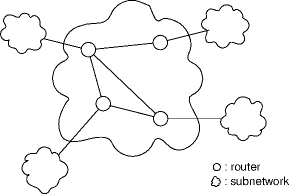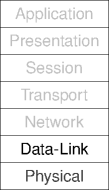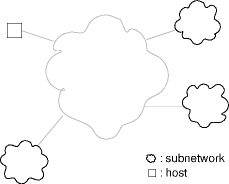Outline
- Review
- Data-link layer and end-point connectivity.
- Data-link layer services.
- Reliability and connectivity.
- Example data-link layer protocols.
- Perfect links.
- Rate mismatched links.
- Corrupting links.
Where We Were
The Data-Link Layer
What are Subnets?
- Shared (multiaccess, broadcast, random access) channels.

- Point-to-point channels.

A Little More Detail
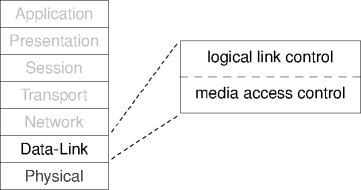
- Separate services provided from implementation.
Data-Link Sublayers

- Logical link control frames data and ensures transmission
characteristics.
- Media access control accesses the physical layer appropriately.
Point-to-point: relatively easy.
Shared: considerably harder.
Data Link Services
- Data transmission.
- Unacknowledged connectionless service.
- Acknowledged connectionless service.
- Acknowledged connection-oriented service.
- Multiplex a single channel.
- Addressing.
Error Control
- Reliable data-link transmissions should recognize and handle errors.
- It’s more efficient at the data-link layer, but not necessary
- The usual schemes come into play at the data-link layer:
- Acknowledgments provide feedback.
- Sender time-outs recover from lost acks.
- Sequence numbers protect against duplicates.
Flow Control
- Heterogeneous end-points may have mismatched capabilities.
- Flow control smooths over end-point differences.
- Flow control can be either rate-based or feedback-based.
- Modern network interface cards (NICs) tend to make flow control a less
serious problem.
- But old or limited end-points.
Addressing
- Data-link layer hosts are identified by a MAC address.
- Assigned to the interface.
- A MAC address is 6 bytes (48 bits) in two 3-byte parts.

- Specified as 12 hex digits.
MAC Address Examples
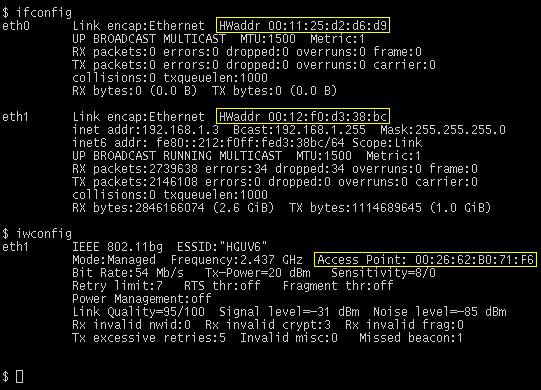
- 00:11:25 — IBM; 00:12:f0 — Intel;
00:26:62 — Actiontec Electronics.
Basic Data-Link Protocols
- Correct communication is easy in the absence of errors.
- But there are lots of errors.
- As usual, “correct” means “accurately reproduced” on the
receiver side.
- Spatial correctness; temporal correctness is another matter.
- The data-link layer is the first (or last) place these matters can
dealt with concretely.
Perfect Links
- Assume perfect links, links that
- are errorless, and
- have rate-matched end-points.
- Data-link PDUs are simple under these conditions.
struct frame
byte payload[]
- But not simple if payload size varies.
Perfect Link Protocol
data-link-sender()
frame f
while true
f.payload = from-network-layer()
to-physical-layer(f)
data-link-receiver()
while true
frame f = from-physical-layer()
to-network-layer(f.payload)
Rate Mismatches
- Remove the rate-matched assumption.
- The sender could overrun the receiver.
- There are two general solutions:
- Rate-based transmission.
- Stop-and-wait transmission.
- Errors and rate-based transmission don’t go well together.
Stop-and-Wait Sender
data-link-sender()
frame f, ack
while true
f.payload = from-network-layer()
to-physical-layer(f)
ack = from-physical-layer()
Stop-and-Wait Receiver
data-link-receiver()
frame ack
while true
frame f = from-physical-layer()
to-network-layer(f.payload)
to-physical-layer(ack)
Link Errors
- Remove the errorless assumption.
- Now frames can be corrupted or lost.
- Corrupted frames can be tossed for a loss.
- Losses can be recovered from on the sender side with time-outs.
- The receiver makes no assumptions about frame arrivals.
- Lost acks could result in duplicate frames being sent.
Error-Handling Sender
data-link-sender()
frame f, ack
event e
f.seq-no = 0
f.payload = from-network-layer()
while true
to-physical-layer(f)
start-timer(f.seq-no)
e = wait-for-event()
if e == frame-arrival
ack = from-physical-layer()
if ack.seq-no == f.seq-no
stop-timer(f.seq-no)
f.payload = from-network-layer()
f.seq-no = (f.seq-no + 1) mod 2
// else time-out, corruption
Error-Handling Receiver
data-link-receiver()
unsigned expected-seq-no = 0
while true
frame f = from-physical-layer()
if frame-uncorrupted(f)
if f.seq-no == expected-seq-no
to-network-layer(f.payload)
expected-seq-no = (expected-seq-no + 1) mod 2
f.payload = []
f.seq-no = 1 - expected-seq-no
to-physical-layer(f)
Summary
- The data-link layer offers transmission service to the network layer.
- Reliable or not, connectionless or not.
- Link-channel complexity causes the logical-link and media-access
control sublayers split.
- The data-link (and physical) layer is where network abstractions are
implemented.
- The end-to-end argument becomes clear at the data-link layer.
References
|
This page last modified on 2014 October 20.
|

|
